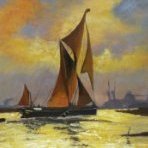-
Posts
1,368 -
Joined
-
Last visited
About FriedClams

Profile Information
-
Gender
Male
Recent Profile Visitors
-
 woodartist reacted to a post in a topic:
Pelican 1943 by FriedClams - 1:48 - Eastern-Rig Dragger
woodartist reacted to a post in a topic:
Pelican 1943 by FriedClams - 1:48 - Eastern-Rig Dragger
-
 vvvjames reacted to a post in a topic:
USS Tennessee 1869 by Keith Black - scale 1:120 - Wood Hull Screw Frigate - ex Madawaska 1865
vvvjames reacted to a post in a topic:
USS Tennessee 1869 by Keith Black - scale 1:120 - Wood Hull Screw Frigate - ex Madawaska 1865
-
 KenW reacted to a post in a topic:
Washington 1776 by KenW - 1:48 - Continental galley from NRG plans
KenW reacted to a post in a topic:
Washington 1776 by KenW - 1:48 - Continental galley from NRG plans
-
 AJohnson reacted to a post in a topic:
DeHavilland Mosquito FB Mk VI by Danstream - Tamiya - 1/48 - PLASTIC
AJohnson reacted to a post in a topic:
DeHavilland Mosquito FB Mk VI by Danstream - Tamiya - 1/48 - PLASTIC
-
 FriedClams reacted to a post in a topic:
Muscongus Bay Lobster Smack by JacquesCousteau - Model Shipways - 1:32 - Rescaled and Modified
FriedClams reacted to a post in a topic:
Muscongus Bay Lobster Smack by JacquesCousteau - Model Shipways - 1:32 - Rescaled and Modified
-
 FriedClams reacted to a post in a topic:
Muscongus Bay Lobster Smack by JacquesCousteau - Model Shipways - 1:32 - Rescaled and Modified
FriedClams reacted to a post in a topic:
Muscongus Bay Lobster Smack by JacquesCousteau - Model Shipways - 1:32 - Rescaled and Modified
-
 FriedClams reacted to a post in a topic:
Muscongus Bay Lobster Smack by JacquesCousteau - Model Shipways - 1:32 - Rescaled and Modified
FriedClams reacted to a post in a topic:
Muscongus Bay Lobster Smack by JacquesCousteau - Model Shipways - 1:32 - Rescaled and Modified
-
 FriedClams reacted to a post in a topic:
Muscongus Bay Lobster Smack by JacquesCousteau - Model Shipways - 1:32 - Rescaled and Modified
FriedClams reacted to a post in a topic:
Muscongus Bay Lobster Smack by JacquesCousteau - Model Shipways - 1:32 - Rescaled and Modified
-
 FriedClams reacted to a post in a topic:
Muscongus Bay Lobster Smack by JacquesCousteau - Model Shipways - 1:32 - Rescaled and Modified
FriedClams reacted to a post in a topic:
Muscongus Bay Lobster Smack by JacquesCousteau - Model Shipways - 1:32 - Rescaled and Modified
-
 FriedClams reacted to a post in a topic:
Muscongus Bay Lobster Smack by JacquesCousteau - Model Shipways - 1:32 - Rescaled and Modified
FriedClams reacted to a post in a topic:
Muscongus Bay Lobster Smack by JacquesCousteau - Model Shipways - 1:32 - Rescaled and Modified
-
 FriedClams reacted to a post in a topic:
Muscongus Bay Lobster Smack by JacquesCousteau - Model Shipways - 1:32 - Rescaled and Modified
FriedClams reacted to a post in a topic:
Muscongus Bay Lobster Smack by JacquesCousteau - Model Shipways - 1:32 - Rescaled and Modified
-
 FriedClams reacted to a post in a topic:
Muscongus Bay Lobster Smack by JacquesCousteau - Model Shipways - 1:32 - Rescaled and Modified
FriedClams reacted to a post in a topic:
Muscongus Bay Lobster Smack by JacquesCousteau - Model Shipways - 1:32 - Rescaled and Modified
-
 FriedClams reacted to a post in a topic:
Sternwheeler and Barge From the Susquehanna River's Hard Coal Navy by Keith Black - FINISHED - 1:120 Scale
FriedClams reacted to a post in a topic:
Sternwheeler and Barge From the Susquehanna River's Hard Coal Navy by Keith Black - FINISHED - 1:120 Scale
-
 FriedClams reacted to a post in a topic:
Sternwheeler and Barge From the Susquehanna River's Hard Coal Navy by Keith Black - FINISHED - 1:120 Scale
FriedClams reacted to a post in a topic:
Sternwheeler and Barge From the Susquehanna River's Hard Coal Navy by Keith Black - FINISHED - 1:120 Scale
-
 Canute reacted to a post in a topic:
Queen Anne's Revenge with Greek Fire by Glen McGuire - FINISHED - 1/400 - BOTTLE
Canute reacted to a post in a topic:
Queen Anne's Revenge with Greek Fire by Glen McGuire - FINISHED - 1/400 - BOTTLE
-
 Paul Le Wol reacted to a post in a topic:
Queen Anne's Revenge with Greek Fire by Glen McGuire - FINISHED - 1/400 - BOTTLE
Paul Le Wol reacted to a post in a topic:
Queen Anne's Revenge with Greek Fire by Glen McGuire - FINISHED - 1/400 - BOTTLE
-
 Glen McGuire reacted to a post in a topic:
Queen Anne's Revenge with Greek Fire by Glen McGuire - FINISHED - 1/400 - BOTTLE
Glen McGuire reacted to a post in a topic:
Queen Anne's Revenge with Greek Fire by Glen McGuire - FINISHED - 1/400 - BOTTLE
-
Excellent progress, Glen! Thanks for the link to those micro drill bits. Many of the bits I currently have are useless junk and I'm eager to try something else. Gary
- 156 replies
-
- Queen Annes Revenge
- bottle
-
(and 1 more)
Tagged with:
-
An interesting project, Glen - well, all your builds are creative and interesting. Best of luck on this toasty hot new SIB. Gary
- 156 replies
-
- Queen Annes Revenge
- bottle
-
(and 1 more)
Tagged with:
-
Catching up, Marc and what great work you're doing! I particularly like the capstan. Very interesting work with the Bondo. If it does release from the mold intact, it is a process I must remember to try sometime. Gary
- 2,696 replies
-
- heller
- soleil royal
-
(and 9 more)
Tagged with:
-
Really nice progress, Phil. The rack of instrumentation looks great and nice job on the itty-bitty drawer pulls. Gary
- 442 replies
-
- minesweeper
- Cape
-
(and 1 more)
Tagged with:
-
Wonderful work all around, Keith! I especially like the steam engine as well as all the other sub-atomic details you’re adding. Great stuff and yes, that Myers pump is a visual gem. Gary
- 457 replies
-
- sternwheeler
- Hard Coal Navy
-
(and 1 more)
Tagged with:
-
So very happy to hear of this positive health news, Keith. Fantastic. And the sternwheeler is looking great. Gary
- 457 replies
-
- sternwheeler
- Hard Coal Navy
-
(and 1 more)
Tagged with:
-
How have I missed this build until today? Another great subject and masterful craftsmanship at every step. Once again, Valeriy, your brass work is a tour de force and so instructive to follow. The geometry of the ventilator visors realized as a flat strip of brass (even if pieced) strikes me as rather tricky. Fantastic work! Gary
-
Such a beautiful model, JC. Excellently built and weathered with a very realistic look and authentic feel. Congratulations! Gary
- 312 replies
-
- Chile
- Latin America
-
(and 6 more)
Tagged with:
About us
Modelshipworld - Advancing Ship Modeling through Research
SSL Secured
Your security is important for us so this Website is SSL-Secured
NRG Mailing Address
Nautical Research Guild
237 South Lincoln Street
Westmont IL, 60559-1917
Model Ship World ® and the MSW logo are Registered Trademarks, and belong to the Nautical Research Guild (United States Patent and Trademark Office: No. 6,929,264 & No. 6,929,274, registered Dec. 20, 2022)
Helpful Links
About the NRG
If you enjoy building ship models that are historically accurate as well as beautiful, then The Nautical Research Guild (NRG) is just right for you.
The Guild is a non-profit educational organization whose mission is to “Advance Ship Modeling Through Research”. We provide support to our members in their efforts to raise the quality of their model ships.
The Nautical Research Guild has published our world-renowned quarterly magazine, The Nautical Research Journal, since 1955. The pages of the Journal are full of articles by accomplished ship modelers who show you how they create those exquisite details on their models, and by maritime historians who show you the correct details to build. The Journal is available in both print and digital editions. Go to the NRG web site (www.thenrg.org) to download a complimentary digital copy of the Journal. The NRG also publishes plan sets, books and compilations of back issues of the Journal and the former Ships in Scale and Model Ship Builder magazines.













